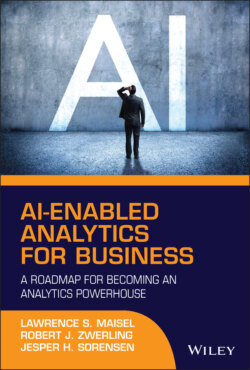Читать книгу AI-Enabled Analytics for Business - Lawrence S. Maisel - Страница 13
BI AND DATA VISUALIZATION VS. ANALYTICS
ОглавлениеBusiness intelligence (BI) tools date back to the 1980s and enabled multidimensional reporting. BI went beyond spreadsheets to ingest large amounts of data from several data sources and then segment (into separate dimensions) the data into hierarchies. This approach gave users the ability to organize and dive into more data more intelligently.
Today, legacy BI tools have essentially become data-marts for data extraction into spreadsheets for reporting. BI tools are largely maintained by IT and require programming to build cubes (specialized BI databases) to respond to predefined questions. However, legacy BI is too rigid and complex for most users, so IT departments often program user-requested reports and data extractions (for download to other applications).
The complexity of BI gave birth to data visualization tools that were introduced in the 2000s and offered graphic representations of data in many forms, often combined into dashboards to render a story about key aspects of the business. Dashboards can be informative but typically not analytical.
The reference to data visualization says it all in its name. It is visualizing data, not applying mathematics on data. An excerpt from a 2019 report from the Finance Analytics Institute (www.fainstitute.com), “Visualization vs. Analytics, what each tool is, how they are different & where they apply,” offers a clear discussion of visualization:4
Dashboards are of prime value to combine visual charts with tabular data of KPIs and key values for comparisons.
The picture below is … where data and images of trends can work together to offer a view to the past and present. Like a car's dashboard, the numerical readings at the top tell key performance data needed to be known; e.g. if we're running low on gas…
But dashboards are not predictive, and views of past data can lead to false negatives or positives of the future. Look at the image below [Figure A]…
The historical trend is essentially up. So, what's the next bar to follow? Up? Down? What decision would you make if you predicted up? What would happen if you guessed wrong? As seen on the chart below [Figure B], the next bar was substantially down.
Figure A
Figure B
Visualization gives colors and images that intrigue the eye. But there is pretty and there is practical, and the two should not be confused—although they often are. Far too frequently, dashboards become an exercise in art vs. business. The rendering of a dashboard should be to make better decisions; so when viewing a dashboard, always ask, “Will what I'm seeing help inform me to make a better decision? What decision?” If the answer is not definitive, then the dashboard is art, not business.
We like to say that AI and analytics can torture data until it confesses! The “confession” obtained from analytics, which applies mathematics on data, can better inform us about the future; and decisions are about the future! Consider, have you ever made a decision about the past? Well, no, other than to say that the decision you made when the past was the future turned out to be a good or bad decision. While this bit of time travel may be confusing, the point is that using tools that display data from the past is only part of the inputs needed to make decisions about the future.
Therefore, it is important to distinguish that data visualization is largely a tool of reporting and displaying past data and information, whereas AI and analytics tools use past data to bring insights that make predictions and forecasts about the future.
For example, returning to the two charts in Figure A and Figure B, the question was what the next bar would be on the trend in Figure A: up or down? A viewer of the chart might lean to up because the general direction of the trend is up or due to a personal need/desire to have the trend continue up. However, applying the statistical process control index on the data in Figure A would predict the next bar to be materially down—which it was, as depicted in Figure B.
This is a beautiful example of applied statistics to reveal an unbiased insight that can, and should, materially impact a decision. Whereas reporting and data visualization informs what happened and where it happened, analytics powerfully advises what will happen and how to make it happen. As we shall explore in depth in Chapter 5, using the full range of tools, decisions can be enhanced through information and insights that span a continuum of time in the past, present, and future.
